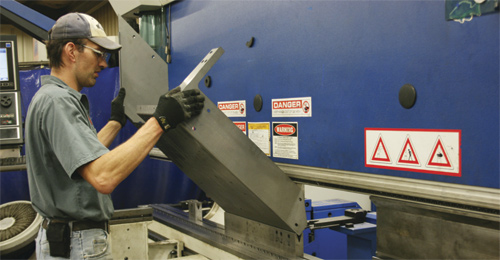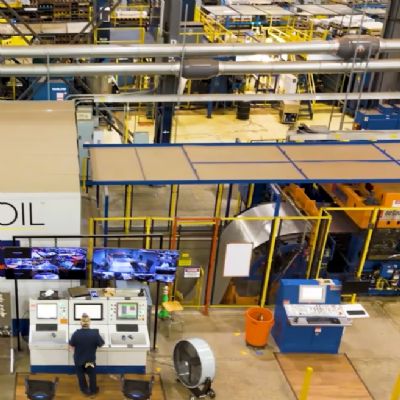New Technology, New Levels of Quality
• Closer monitoring of the piercing process to yield considerable time savings when processing thicker sheetmetal;
• Minimized axis movements, to boost throughput; and
• Automatic adjustment of beam focal length.
As a result of these and other innovations, here’s where fabricators are enjoying quality improvements:
• Surface roughness: 10 micrometers for sheetmetal 0.15 in. thick is the target for eliminating refinishing at visible edges.
• Perpendicularity: With proper adjustment, the deviation from a right angle can be limited to 0.004 in. in sheet 0.4 in. thick.
• Kerf width: While the width of the cut inevitably rises with increasing sheet thickness, it is a scant 0.006 in. for sheet about 0.10 in. thick.
• Groove deflection: Reducing the advancing speed can almost completely eliminate the groove trailing effect, even in thick sheet.
• Burr-free: Laser cutting eliminates burrs and thereby the additional step typically required to finish the edges, an important quality feature.
• Pitting: Just like erosion, pitting interrupts the regular cutting surface and can be avoided with the appropriate parameters.
A Crusading Fabricator
Eric Schleich, president of metal-fabrication shop E.S. Metal, Terryville, CT, and a devoted user of CO2-laser cutting technology, is the kind of guy who defies all odds. He received top honors in school for industrial arts, but had a reputation as a renegade in spite of this academic success. School officials enrolled him at E.C. Goodwin Technical High School in New Britain, CT, where the plan was for Eric to learn to be a plumber. But it was machine tools that caught his eye.
“The machine shop blew me a,” he says. “I immediately knew that this is what I wanted to do.” You won’t find Eric, now in his early 50s, crawling under kitchen sinks nor snaking drains. Instead, he’s running a successful precision sheetmetal-fabrication business that he founded in 1985. He runs the 20-person 30,000-sq-.ft. facility alongside his brother Russell (vice president) and his son Kyle, the company’s lead programmer.
From humble beginnings in a basement, with a scant few cutting, forming and welding machines, E.S. Metal has grown into a global supplier of sophisticated metal products. It serves customers in diverse industries such as air cargo, office equipment, munitions, trucking, telecommunications, chemicals, pharmaceutical, public utilities, aerospace, feed and grain, entertainment and sound control.
The U.S. military frequently taps the company for rapid-prototype development, including recovery trailers and protective turrets that sit on top of Humvees as shields for soldiers who serve as gunners. And Schleich notes that the speed and flexibility of its laser-cutting machines play a significant roll in attracting this business.
The shop over the years has run several generations of CO2-laser-cutting machines, the latest of which are a pair of 4000-W machines. Both models are Trumpf TruLaser 4030 models that feature 80- by 160-in. worktables, and which, says Schleich, “cut 1-in. steel beautifully.”
Some 80 percent of the material processed through E.S. Metal is cut on its laser-cutting machines. “All of our customers request the edge quality that only lasers can provide,” Schleich says. “At one point we were laser cutting stainless steel about 90 percent of the time, when our customer base included numerous companies serving the plating industry. When a lot of that work went to Mexico, we reinvented ourselves. Now, a significant percentage of our work is cutting mild steel for customers in a variety of industries, including automotive and green-energy applications. We don’t try to steer the boat, we just follow the current.”
E.S. Metal’s active customer base numbers around 50. Sixty percent of those customers are big repeaters, the remainder small one-off work. “We have a lot of people from the community stop in and ask us to make a single part for them,” says Eric. And while those types of requests certainly aren’t profitable, E.S. Metal’s founder says he tries his best to honor them.
After all, he points out, “That’s why we’re in this business. We’re here to help people.” MF
View Glossary of Metalforming Terms
See also: TRUMPF Inc.
Technologies: Cutting







 Brilliant solid-state lasers, regardless of whether they use a disk, fiber or rod, have been widely discussed in recent months. Throughout, one thing that has remained clear: The CO2 laser is defending its enviable position as the all-purpose cutting machine.
Brilliant solid-state lasers, regardless of whether they use a disk, fiber or rod, have been widely discussed in recent months. Throughout, one thing that has remained clear: The CO2 laser is defending its enviable position as the all-purpose cutting machine. 




